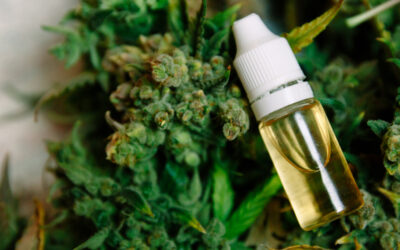[vc_row][vc_column][vc_column_text]As more and more states pass medical marijuana and recreational marijuana laws that allow for legal personal cultivation, many people are interested in learning how to grow cannabis at home. Taking the plunge and growing your own cannabis can be cost-effective and gives you full control of how your cannabis is cultivated.
Caring for your own cannabis can present a unique set of challenges to newcomers, particularly during the plant’s’ flowering process. However, once you learn the basics, which are pretty simple, you can easily produce your own indefinite supply of flowering cannabis.
WHAT IS THE FLOWERING PROCESS?
The flowering process is the final phase in cannabis cultivation, which happens right before the plant’s flowers, or “buds,” are harvested. It’s the process during which your plant has become fully mature and begins to produce useable cannabis flower.
While the flowering process can take eight or more weeks, for personal growers it’s often the most satisfying of all the steps of cannabis cultivation because it’s when all your hard work and devotion to your plants pays off.
You as a grower stimulate the flowering process by making a specific change to the plant’s lighting cycle. During this stage, cannabis plants typically need a little more monitoring and care.
As a cannabis grower, you must be attentive here, as your actions during the flowering process will have a significant impact on the final flower production of your plants. You’ll need to make adjustments to lighting and feeding. It’s not uncommon for a cannabis plant to go into shock as it enters the flowering phase, so be ready to keep an eye on your plants.
Before you begin the flowering process, you may notice that cannabis plants begin to develop two white hairs at their nodes, or stem junctions. These “pre-flowers” are a clear sign that your cannabis plants are ready to start the flowering phase.
STAGES OF FLOWERING PROCESS[/vc_column_text][vc_gallery type=”image_grid” images=”28074,28075″ img_size=”medium”][/vc_column][/vc_row][vc_row][vc_column][vc_column_text]Early Flowering (Weeks 1-2)
The early flowering stage is when your plants transition from the vegetative stage to the flowering stage.
Only a few days after you change your lighting cycle to stimulate the flowering process, you should notice pistils develop as the flowers build resin glands, calyxes, and single support leaves.
Pistils, which contain the reproductive parts of a flower, look like wispy white hairs. Resin glands, or trichomes, are what produce the cannabinoids and terpenes of the plant. They look like small, translucent mushrooms that protrude from the plant. The calyx, the first part of the flower that forms during the flowering process, appears as a platform of small leaves called sepals.
Over the two or so weeks, your plant will rapidly gain height and the plant’s white pistils will start to turn into small buds.
[/vc_column_text][/vc_column][/vc_row][vc_row][vc_column][vc_gallery type=”image_grid” images=”28076,28077″ img_size=”medium”][/vc_column][/vc_row][vc_row][vc_column][vc_column_text]Peak Flowering (Weeks 3-5)
At the beginning of the peak flowering phase, a few resin glands will be present on the flower. You’ll see huge changes in your plant throughout this phase.
By week four, the vegetative growth on the plant will have ended and the plant will be able to focus its energy on flowering. Bud density will continue to increase and the plant’s odor will become more noticeable as more trichomes are produced.
As you move into week five of the flowering process, the cannabis plant’s flower production will sharply increase. The buds will appear well developed with nearly all white pistils sticking straight up in every direction. Their resin glands should be dense and their floral structure mature. Also, the trichomes will start to turn opaque.
It’s during the peak flowering stage that cannabis flowers produce the most terpenes and cannabinoids like THC and CBD.
[/vc_column_text][/vc_column][/vc_row][vc_row][vc_column][vc_gallery type=”image_grid” images=”28073,28072″ img_size=”medium”][/vc_column][/vc_row][vc_row][vc_column][vc_column_text]Late Flowering (Week 6-8+)
Around week six, your cannabis plants will enter the late flowering stage. You’ll notice the plant’s resin glands and bud hairs beginning to deteriorate. A very strong odor will come from your plant.
Once your plants enter this late flowering stage, you know you’re only about eight to 14 days from harvest.
Harvest
The simplest way to know when you cannabis flower is ready to be harvested is by examining the plant’s pistils. At the beginning of the flower process, the hairs will be white and stringy. Through the flowering process, they will turn orange and start to curl in. Once they turn dark red or brown, it’s time to harvest your flower.
With a magnifying glass, you can also check the plant’s resin glands. Once they’ve turned from a translucent to a creamy or milky white color, the flower is likely ready for harvest.
HOW TO TAKE CARE OF CANNABIS DURING THE FLOWERING PROCESS
Strict 12/12 Lighting Schedule
Once your plants have developed enough and are ready to begin the flowering process, change their light cycle to an even 12 hours of light and 12 hours of dark each day. This makes the plant believe the fall season has arrived, and will cause them to transition from their vegetative state to the final flowering process.
During the 12 hours of light each day, the plants will need the strongest light possible to help produce energy for flowers. Either make sure your plant can be in direct sunlight for the 12 hours, or move your plant into an enclosed location where you can hang a heating lamp overhead. If the lamp is high intensity, keep it about two feet away from the plants. Consider using a standard outlet timer and set it to a 12-hour cycle for the light cycle to be more precise.
During the 12 hours of darkness each day, it’s extremely important that no light enter the location of the plants. Any light that leaks into the plant space can disrupt the flowering of the cannabis and cause stress to or confuse the plant. This can adversely affect flower yield and quality and even potentially cause the plant to create seeded flowers.
Nutrient and Watering Needs
Before the flowering process, you will have been supplying your cannabis plants with feeds that contain nitrogen nutrients. Stop with nitrogen once you move into the flowering process. At this point, the plants need more phosphorus and potassium for bud building. They also need magnesium and some sulfur.
You may want to stop feeding your cannabis plants about two weeks before the flowering process finishes, in the late flowering stage, to allow watering to rinse minerals out of the plant. This “flushing” or “leaching” process forces the plant to use up stored food reserves so that they’re not present in the plant when the cannabis is consumed.
Air Circulation, Temperature and Humidity
Ideally throughout the flowering process, temperature changes slightly between the light and dark cycles. During the 12-hour light cycle, when lights are on, try to keep the temperature in your growing area between 75 to 85 degrees Fahrenheit. During the 12-hour dark cycle, when lights is removed, temperature should drop slightly to mimic night.
Keep the humidity at a steady 70 percent to prevent pest issues and encourage better flower production. While you don’t want fans to blow directly on the plants for extended periods, keeping fresh air circulating by blowing it around the plants will help ensure proper ventilation.
Growing your own cannabis isn’t particularly difficult, but it does require a little attention if you’re looking to maximize flower production.
You can learn more about cannabis through our research and education page.[/vc_column_text][/vc_column][/vc_row]






